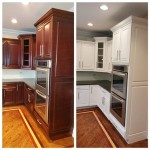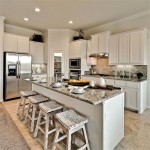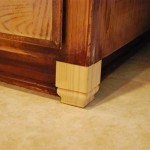Navigating the Storage Potential of Blind Corner Cabinets
Blind corner cabinets, a common feature in kitchen designs, present a unique storage challenge. Characterized by a deep recess that is difficult to access directly, these cabinets often exist at the junction of two perpendicular cabinet runs. The "blind" aspect refers to the obscured portion within the cabinet, making it challenging to see and reach items stored in the far corners. Understanding the purpose and potential solutions for blind corner cabinets is crucial for maximizing kitchen space and improving overall kitchen functionality.
These cabinets are a necessary byproduct of standard cabinet construction and kitchen layouts. When kitchen designs incorporate 90-degree angles or unusual room dimensions, blind corners often arise. Instead of leaving these spaces empty and inaccessible, designers incorporate blind corner cabinets to utilize the area for storage, albeit with the understanding that special solutions are often needed to make the space truly usable. Without these cabinets, valuable space would be wasted, potentially impacting the overall storage capacity of the kitchen.
The primary purpose of a blind corner cabinet is to provide storage where standard cabinet configurations would otherwise leave a void. However, due to the inherent accessibility issues, merely placing items inside without organization often leads to frustration and underutilization of the space. Effective management of a blind corner cabinet requires the implementation of specific organizational strategies or specialized hardware.
Maximizing Storage with Specialized Hardware
One of the most effective ways to enhance the usability of a blind corner cabinet is through the integration of specialized hardware. This hardware is designed to overcome the accessibility challenges and bring items stored in the back of the cabinet to the forefront. Several types of hardware solutions exist, each with its own benefits and drawbacks.
A popular option is the "lazy Susan," a rotating shelf system. Modern lazy Susans for blind corners often feature two or more kidney-shaped shelves that pivot independently. When the cabinet door is opened, one or both shelves can be rotated outwards, bringing items from the back of the cabinet within easy reach. These systems are relatively simple to install and offer a good balance between cost and functionality.
Another solution is the "pull-out" or "swing-out" system. These systems typically consist of a series of shelves or baskets that are attached to a mechanism that allows them to be pulled or swung out of the cabinet. When the door is opened, the entire shelf system can be extended, providing full access to all items stored within. Pull-out systems are generally more expensive than lazy Susans but offer superior accessibility and organization.
Furthermore, some manufacturers offer "magic corner" units. These are sophisticated pull-out systems that utilize a series of interconnected shelves. When the door is opened, the front shelves swing outwards, and the rear shelves automatically pull forward to occupy the space vacated by the front shelves. This configuration maximizes accessibility and ensures that even items stored in the deepest recesses of the cabinet are easily within reach. These systems are often the most expensive option but provide the highest level of functionality for blind corner cabinets.
When selecting hardware for a blind corner cabinet, it is important to consider the size and configuration of the cabinet, the types of items that will be stored, and the overall budget. Measuring the available space accurately is crucial to ensure that the chosen hardware will fit properly and function as intended. It is also advisable to consider the weight capacity of the hardware and choose a system that can adequately support the intended load.
Strategic Organization for Optimal Use
In addition to specialized hardware, strategic organization plays a vital role in maximizing the usability of blind corner cabinets. Even with the best hardware, a poorly organized cabinet can still be difficult to navigate. Implementing effective organizational strategies can help to streamline the storage process and ensure that items are easily accessible when needed.
One fundamental principle of organization is to group similar items together. This allows for efficient retrieval and prevents items from becoming lost or misplaced. For example, baking supplies can be stored together in one section of the cabinet, while pots and pans can be stored in another. Using clear containers and labels can further enhance organization and make it easier to identify the contents of each container.
Another important consideration is the frequency of use. Items that are used frequently should be stored in the most accessible areas of the cabinet, while items that are used less often can be stored in the deeper, less accessible areas. This ensures that the most essential items are always within easy reach. It may also be beneficial to rotate items periodically, bringing less frequently used items to the front and pushing more frequently used items to the back.
Utilizing vertical space is another key aspect of effective organization. Installing adjustable shelves or utilizing stackable containers can help to maximize the storage capacity of the cabinet and prevent items from becoming piled on top of each other. Consider using shelf dividers to create separate compartments for different items and prevent them from shifting or falling over.
Furthermore, consider the weight and size of the items being stored. Heavier items should be stored on the lower shelves to maintain stability and prevent the cabinet from tipping over. Larger items may require more specialized storage solutions, such as adjustable dividers or custom-built shelves.
Alternative Uses Beyond Standard Kitchen Items
While blind corner cabinets are typically used for storing kitchen items, they can also be utilized for other purposes, depending on the specific needs and preferences of the homeowner. Thinking outside the box can unlock additional storage potential and maximize the functionality of the space.
In some cases, a blind corner cabinet can be used as a pantry extension. If the main pantry is already full, the blind corner cabinet can provide additional storage space for non-perishable food items, such as canned goods, cereals, and snacks. This can be particularly useful for families with limited pantry space or those who tend to stockpile food items.
A blind corner cabinet can also be adapted to store small appliances, such as blenders, food processors, and stand mixers. These appliances can take up a significant amount of counter space, so storing them in a blind corner cabinet can help to declutter the kitchen and create a more streamlined appearance. Ensure the chosen appliances fit comfortably and that there is sufficient clearance for operation, especially if using a pull-out system.
Furthermore, a blind corner cabinet can be used to store cleaning supplies, such as detergents, cleaning cloths, and sponges. This can be particularly useful if there is no dedicated cleaning supply closet in the kitchen. However, it is important to ensure that cleaning supplies are stored safely and securely, away from food items and out of reach of children and pets.
Another alternative is to use the blind corner cabinet to store pet supplies, such as pet food, bowls, and toys. This can be particularly useful for pet owners who want to keep their pet supplies organized and out of sight. Ensure that the pet supplies are stored in airtight containers to prevent odors and pests.
The key to successfully repurposing a blind corner cabinet is to carefully consider the types of items that will be stored and adapt the cabinet to meet those specific needs. This may involve adding shelves, dividers, or other organizational accessories to create a customized storage solution.
Ultimately, the most effective use of a blind corner cabinet depends on individual circumstances and preferences. By considering the various options and implementing strategic organizational techniques, homeowners can transform this often-underutilized space into a valuable asset in their kitchen.

Blind Corner Cabinets Step By Guide On How To Install

How To Make Blind Corner Cabinet Space More Useful

What Is A Blind Corner Cabinet The Homestud

Blind Corner Cabinet Ideas To Maximize Space

Blind Corner Accessories Info

Blind Corner Cabinets Step By Guide On How To Install

How To Make Blind Corner Cabinet Space More Useful

What Is A Blind Corner Cabinet The Homestud

How To Deal With The Blind Corner Kitchen Cabinet Live Simply Method

Diy Corner Cabinet With No Wasted Space Sawdust Girl
Related Posts








